ENGLISH CHURCH WOODWORK.
[To THE EDITOR OF THE " SPECTAT0112] feel I must enter a brief protest against the article by your contributor "C. W.-E." in reference to Crossley and Howard's English Church Woodwork, published by my company. Your contributor takes strong exception to the fact that the book does not deal with post-Reformation work, but the whole of his argument is built upon a false assumption, because he has not taken the trouble to grasp the title or the soope of the book. The title is English Church Woodwork: a Study in Craftsmanship during the Mediaeval Period, 1250-1550, and the work is necessarily confined to Gothic work, because the extent of the whole range of the subject and the wide field of its examples preclude adequate treatment in a single volume. The whole of the words after " Woodwork " are omitted at the bottom of the article from the title, which is, therefore, presented in so mutilated a form as to convey an entirely false impression of what the book purports to include. Hence your contributor's remarks are rather in the nature of tilting at windmills, or may be compared to the pulpit tactics of the old-fashioned clergyman who set up a chimera in order to demolish it. The book is already a large one, and it would have been possible, In view of the interest of the subject and the amount of fine woodwork, to have accorded ampler treat- ment even to woodwork of mediaeval times. So far from having any dislike of the woodwork of the Renaissance, the authors in more than one Place pay a tribute to its masterly design and splendid workmanship; this, however, has escaped the notice of your contributor, who has preferred to use the book as a peg on which to hang a disquisition of his own.
No exception can be taken to the tenor of his remarks about post-Reformation woodwork, but it is unfair to all concerned in the book to suggest that the exclusion of subjects after the middle of the sixteenth century is due to a prejudice against the later work. On the contrary, Mr. Crossley has already photographed a large number of post-Reformation examples, and it is hoped at a later date to publish a similar volume on the work down to the end of the eighteenth century. There is a large amount of beauti- ful work in the country, snuck of it still to be explored, and the only doubtful factor is the possibility of the survival in •archaeo- logical 'and chiirch circles of nineteenth-century prejudice against Renaissance woodwork, a result of the lingering influence of the writers a the Gothic revival. Personally, I hope " C. W.-E." will continue his helpful" educative writing on the attraction of the woodwork of Jacobean, Stuart, and Georgian times, but there is no need for him to foster and then slay imaginary grievances. So far as we are concerned, we published some years age a large work on the fittings and interiors of Wren's City churches, which, both for my predecessors in the firm and for myself, have always had a



























 Previous page
Previous page